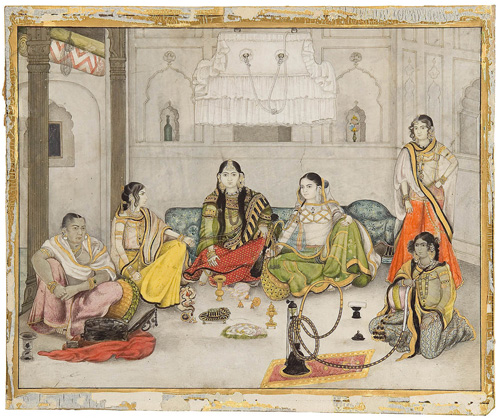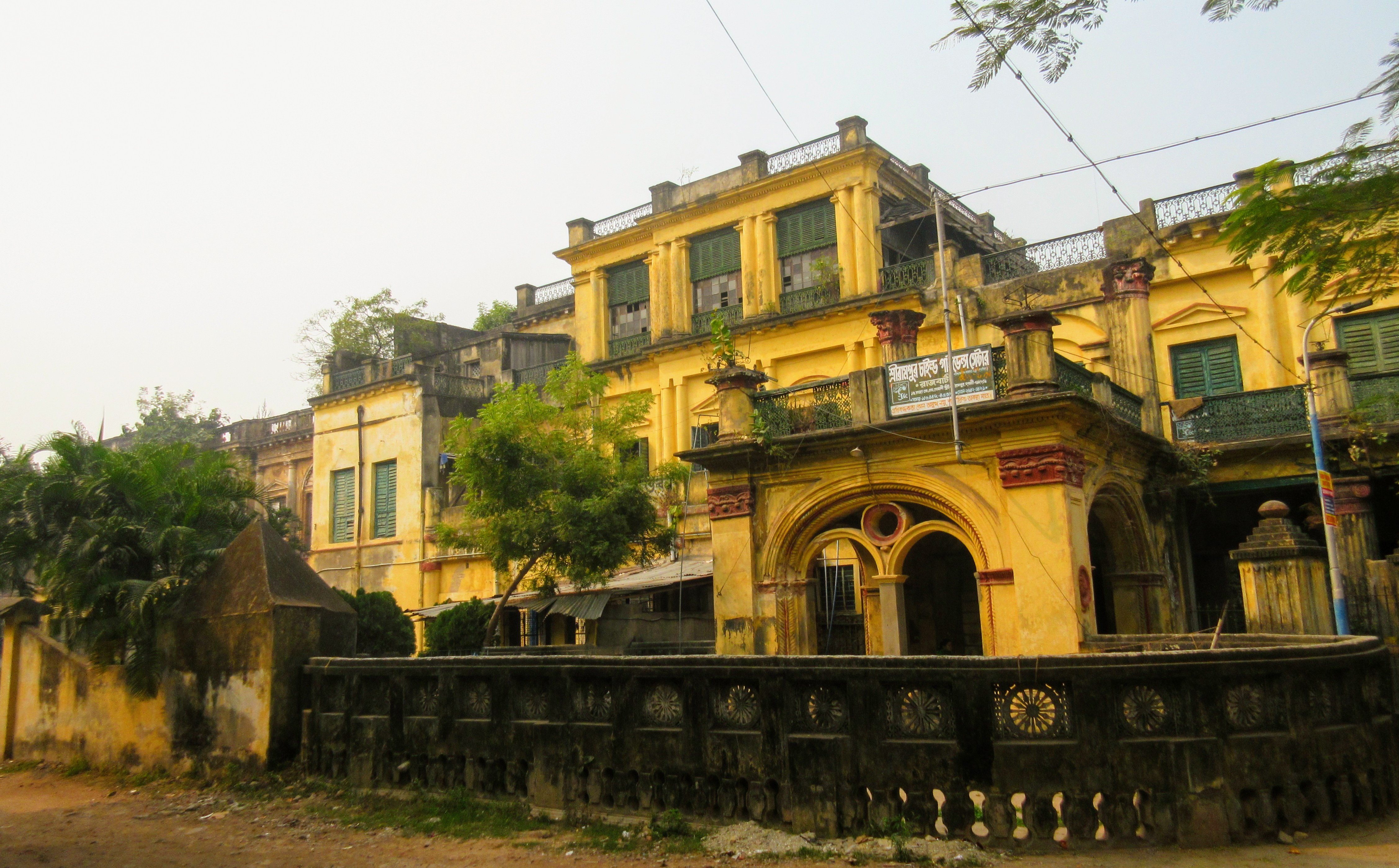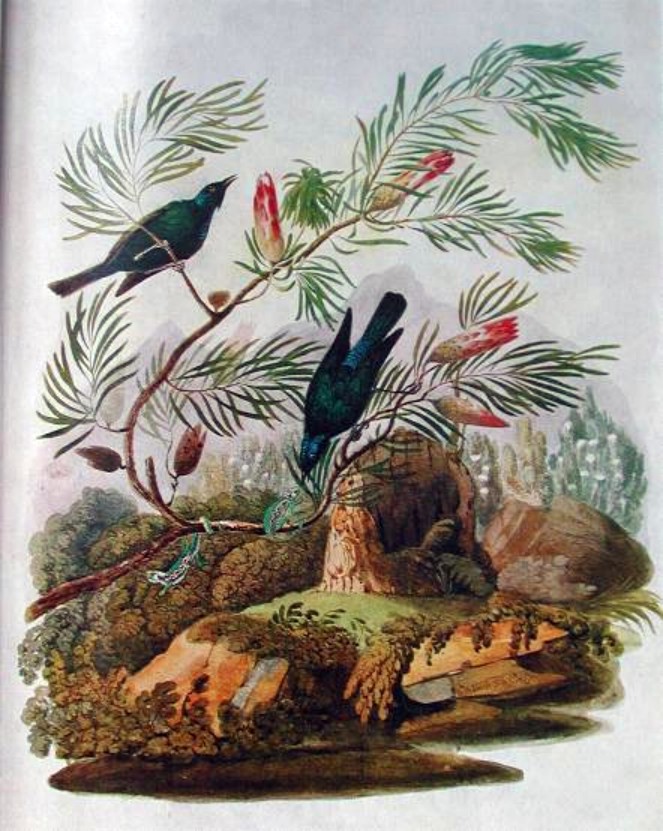|
Charles D'Oyly
Sir Charles D'Oyly, 7th Baronet (1781–1845), was a British public official and painter from Dacca (now Dhaka). He was a member of the Bengal Civil Service based in Calcutta, Dacca and Patna from 1797 to 1838. Although he held senior positions with the East India Company's civil service, he is best known as an amateur artist who published many books featuring engravings and lithographs featuring Indian subject matter. Life and career Charles D'Oyly was born in Murshidabad, Bengal, India on 17 September 1781 into a family that had long served in India. He was the son of Sir John-Hadley D'Oyly, 6th Baronet and Diana Rochfort. His father was the East India Company's resident at the Court of Nawab Babar Ali of Murshidabad. D'Oyly went to England with the family in 1785 and received his first formal education there. In 1798 he returned to India as Assistant to the Registrar in the Court of Appeal in Calcutta. In 1803 he was appointed Keeper of the Records in the Governor General's of ... [...More Info...] [...Related Items...] OR: [Wikipedia] [Google] [Baidu] |
Baronet
A baronet ( or ; abbreviated Bart or Bt) or the female equivalent, a baronetess (, , or ; abbreviation Btss), is the holder of a baronetcy, a hereditary title awarded by the British Crown. The title of baronet is mentioned as early as the 14th century, however in its current usage was created by James VI and I, James I of England in 1611 as a means of raising funds for the crown. A baronetcy is the only British Hereditary title, hereditary honour that is not a peerages in the United Kingdom, peerage, with the exception of the Anglo-Irish Knight of Glin, Black Knights, White Knight (Fitzgibbon family), White Knights, and Knight of Kerry, Green Knights (of whom only the Green Knights are extant). A baronet is addressed as "Sir" (just as is a knight) or "Dame" in the case of a baronetess, but ranks above all knighthoods and damehoods in the Orders of precedence in the United Kingdom, order of precedence, except for the Order of the Garter, the Order of the Thistle, and the dormant ... [...More Info...] [...Related Items...] OR: [Wikipedia] [Google] [Baidu] |
Knighthood
A knight is a person granted an honorary title of knighthood by a head of state (including the Pope) or representative for service to the monarch, the church or the country, especially in a military capacity. Knighthood finds origins in the Greek ''hippeis'' and '' hoplite'' (ἱππεῖς) and Roman '' eques'' and ''centurion'' of classical antiquity. In the Early Middle Ages in Europe, knighthood was conferred upon mounted warriors. During the High Middle Ages, knighthood was considered a class of lower nobility. By the Late Middle Ages, the rank had become associated with the ideals of chivalry, a code of conduct for the perfect courtly Christian warrior. Often, a knight was a vassal who served as an elite fighter or a bodyguard for a lord, with payment in the form of land holdings. The lords trusted the knights, who were skilled in battle on horseback. Knighthood in the Middle Ages was closely linked with horsemanship (and especially the joust) from its origins in th ... [...More Info...] [...Related Items...] OR: [Wikipedia] [Google] [Baidu] |
Company Style
Company style, also known as Company painting or Patna painting (Hindi: ''kampani kalam'') is a term for a hybrid Indo-European style of paintings made in India by Indian artists, many of whom worked for European patrons in the East India Company or other foreign Companies in the 18th and 19th centuries. The style blended traditional elements from Rajput and Mughal painting with a more Western treatment of perspective, volume and recession. Most paintings were small, reflecting the Indian miniature tradition, but the natural history paintings of plants and birds were usually life size. Locations First emerging in Murshidabad, later leading centres were the main British settlements of Calcutta, Madras (Chennai), Varanasi, Delhi, Lucknow, Patna, the Maratha court of Thanjavur and Bangalore. Subjects included portraits, landscapes and views, and scenes of Indian people, dancers and festivals. Series of figures of different castes or trades were particular favourites, with an emphasi ... [...More Info...] [...Related Items...] OR: [Wikipedia] [Google] [Baidu] |
Serampore
Serampore (also called ''Serampur'', ''Srirampur'', ''Srirampore'', ''Shreerampur'', ''Shreerampore'', ''Shrirampur'' or ''Shrirampore'') is a city of Hooghly district in the Indian state of West Bengal. It is the headquarter of the Srirampore subdivision. It is a part of the area covered by Kolkata Metropolitan Development Authority (KMDA) and Greater Kolkata. It is a pre-colonial city on the west bank of the Hooghly River. It was part of Danish India under the name ''Frederiknagore'' from 1755 to 1845. Geography Location Serampore is located at . The area consists of flat alluvial plains, that form a part of the Gangetic Delta. This belt is highly industrialised. Police stations Serampore police station has jurisdiction over Serampore and Baidyabati Municipal areas, and parts of Sreerampur Uttarpara CD Block. Serampore Women police station has been set up. Urbanisation Srirampore subdivision is the most urbanized of the subdivisions in Hooghly district. 73.13% of ... [...More Info...] [...Related Items...] OR: [Wikipedia] [Google] [Baidu] |
Ornithology
Ornithology is a branch of zoology that concerns the "methodological study and consequent knowledge of birds with all that relates to them." Several aspects of ornithology differ from related disciplines, due partly to the high visibility and the aesthetic appeal of birds. It has also been an area with a large contribution made by amateurs in terms of time, resources, and financial support. Studies on birds have helped develop key concepts in biology including evolution, behaviour and ecology such as the definition of species, the process of speciation, instinct, learning, ecological niches, guilds, island biogeography, phylogeography, and conservation. While early ornithology was principally concerned with descriptions and distributions of species, ornithologists today seek answers to very specific questions, often using birds as models to test hypotheses or predictions based on theories. Most modern biological theories apply across life forms, and the number of scientists w ... [...More Info...] [...Related Items...] OR: [Wikipedia] [Google] [Baidu] |
Christopher Webb Smith
Christopher Webb Smith (30 May 1793 Camberwell - 18 January 1871 Florence), was an English-born bird painter and public official. After joining the East India Company he was sent to India in 1811, where he remained in various administrative posts until 1842 and is remembered as a “gentleman naturalist” who specialised in ornithology and illustration. He was one of the first to codify the birds of India. Life and career Smith was born in 1793 at Camberwell, near London, England. He was the son of Captain Donald McKenzie and Anne McLeod (1771-1840), the daughter of John McLeod 91745 -1786), laird of Rasaay in Scotland. Married Annie Jessie MacKenzie (1806- 1862), the daughter of Captain Donald MacKenzie of Hartfields and a native of Scotland in 1824. As a boy, he had shown an interest in birds. At the Fitzwilliam college, Dr W. Carey encouraged him to study Indian birds. India, with its abundance of wildlife, provided him with the opportunity to take up a serious study bird ... [...More Info...] [...Related Items...] OR: [Wikipedia] [Google] [Baidu] |
Company Painting
Company style, also known as Company painting or Patna painting (Hindi: ''kampani kalam'') is a term for a hybrid Indo-European style of paintings made in India by Indian artists, many of whom worked for European patrons in the East India Company or other foreign Companies in the 18th and 19th centuries. The style blended traditional elements from Rajput and Mughal painting with a more Western treatment of perspective, volume and recession. Most paintings were small, reflecting the Indian miniature tradition, but the natural history paintings of plants and birds were usually life size. Locations First emerging in Murshidabad, later leading centres were the main British settlements of Calcutta, Madras (Chennai), Varanasi, Delhi, Lucknow, Patna, the Maratha court of Thanjavur and Bangalore. Subjects included portraits, landscapes and views, and scenes of Indian people, dancers and festivals. Series of figures of different castes or trades were particular favourites, with an empha ... [...More Info...] [...Related Items...] OR: [Wikipedia] [Google] [Baidu] |
Charles D'Oyly11
Charles is a masculine given name predominantly found in English and French speaking countries. It is from the French form ''Charles'' of the Proto-Germanic name (in runic alphabet) or ''*karilaz'' (in Latin alphabet), whose meaning was "free man". The Old English descendant of this word was '' Ċearl'' or ''Ċeorl'', as the name of King Cearl of Mercia, that disappeared after the Norman conquest of England. The name was notably borne by Charlemagne (Charles the Great), and was at the time Latinized as ''Karolus'' (as in ''Vita Karoli Magni''), later also as '' Carolus''. Some Germanic languages, for example Dutch and German, have retained the word in two separate senses. In the particular case of Dutch, ''Karel'' refers to the given name, whereas the noun ''kerel'' means "a bloke, fellow, man". Etymology The name's etymology is a Common Germanic noun ''*karilaz'' meaning "free man", which survives in English as churl (< Old English ''ċeorl''), which developed its depr ... [...More Info...] [...Related Items...] OR: [Wikipedia] [Google] [Baidu] |
Edwin Henry Landseer
Sir Edwin Henry Landseer (7 March 1802 – 1 October 1873) was an English painter and sculptor, well known for his paintings of animals – particularly horses, dogs, and stags. However, his best-known works are the lion sculptures at the base of Nelson's Column in Trafalgar Square. Life Landseer was born in London, the son of the engraver John Landseer A.R.A. and Jane Potts. He was something of a prodigy whose artistic talents were recognised early on. He studied under several artists, including his father, and the history painter Benjamin Robert Haydon, who encouraged the young Landseer to perform dissections in order to fully understand animal musculature and skeletal structure. Landseer's life was entwined with the Royal Academy. At the age of just 13, in 1815, he exhibited works there as an “Honorary Exhibitor”. He was elected an Associate at the minimum age of 24, and an Academician five years later in 1831. He was an acquaintance of Charles Robert Leslie, who d ... [...More Info...] [...Related Items...] OR: [Wikipedia] [Google] [Baidu] |
James Atkinson (Persian Scholar)
James Atkinson may refer to: Sport * James Atkinson (bobsleigh) (1929–2010), American bobsleigh competitor at the Winter Olympics * Jamie Atkinson (born 1990), international cricketer for Hong Kong * James Atkinson (footballer) (born 1995), English goalkeeper for Gretna 2008 * Jim Atkinson (1896–1956), Australian sportsman from Tasmania * Jimmy Atkinson (1886 – after 1910), English footballer for Bolton Wanderers and others Other fields * James Atkinson (surgeon) (1759–1839), English surgeon and bibliographer * James Atkinson (software developer), founder of the phpBB project * James Atkinson (inventor) (1846–1914), inventor of the ''Single-Stroke'' combustion engine in 1882 * James Atkinson (Persian scholar) (1780–1852), published one of the earliest translations of the Shahnameh in English * James Atkinson (JP), first mayor of Crewe, England * James Atkinson (Australian politician) (c. 1820–1873), New South Wales politician * James Atkinson (physicist) (1916–2008) ... [...More Info...] [...Related Items...] OR: [Wikipedia] [Google] [Baidu] |
Cape Of Good Hope
The Cape of Good Hope ( af, Kaap die Goeie Hoop ) ;''Kaap'' in isolation: pt, Cabo da Boa Esperança is a rocky headland on the Atlantic coast of the Cape Peninsula in South Africa. A common misconception is that the Cape of Good Hope is the southern tip of Africa, based on the misbelief that the Cape was the dividing point between the Atlantic and Indian oceans, and have nothing to do with north or south. In fact, by looking at a map, the southernmost point of Africa is Cape Agulhas about to the east-southeast. The currents of the two oceans meet at the point where the warm-water Agulhas current meets the cold-water Benguela current and turns back on itself. That oceanic meeting point fluctuates between Cape Agulhas and Cape Point (about east of the Cape of Good Hope). When following the western side of the African coastline from the equator, however, the Cape of Good Hope marks the point where a ship begins to travel more eastward than southward. Thus, the first mode ... [...More Info...] [...Related Items...] OR: [Wikipedia] [Google] [Baidu] |
Patna
Patna ( ), historically known as Pataliputra, is the capital and largest city of the state of Bihar in India. According to the United Nations, as of 2018, Patna had a population of 2.35 million, making it the 19th largest city in India. Covering and over 2.5 million people, its urban agglomeration is the 18th largest in India. Patna serves as the seat of Patna High Court. The Buddhist, Hindu and Jain pilgrimage centres of Vaishali, Rajgir, Nalanda, Bodh Gaya and Pawapuri are nearby and Patna City is a sacred city for Sikhs as the tenth Sikh Guru, Guru Gobind Singh was born here. The modern city of Patna is mainly on the southern bank of the river Ganges. The city also straddles the rivers Sone, Gandak and Punpun. The city is approximately in length and wide. One of the oldest continuously inhabited places in the world, Patna was founded in 490 BCE by the king of Magadha. Ancient Patna, known as Pataliputra, was the capital of the Magadh Empire through Haryanka, ... [...More Info...] [...Related Items...] OR: [Wikipedia] [Google] [Baidu] |





.jpg)

.jpg)


